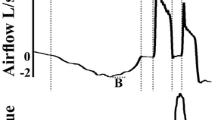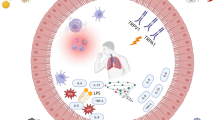Abstract
Cough and swallow are highly coordinated reflex behaviors whose common purpose is to protect the airway. The pharynx is the common tube for air and food/liquid movement from the mouth into the thorax, has been largely overlooked, and is potentially seen as just a passive space. The thyropharyngeus muscle responds to cough inducing stimuli to prepare a transient holding area for material that has been removed from the subglottic airway. The cricopharyngeus muscle participates with the larynx to ensure regulation of pressure when a bolus/air is moving from the upper airway through to the thorax (i.e., inspiration or swallow) or the reverse (i.e., expiration reflex or vomiting). These vital mechanisms have not been evaluated in clinical conditions but could be impaired in many neurodegenerative diseases, leading to aspiration pneumonia. These newly described airway protective mechanisms need further study, especially in healthy and pathologic human populations.


Similar content being viewed by others
References
Canning BJ (2006) Anatomy and neurophysiology of the cough reflex. Chest 129(1 Suppl):33S
Canning BJ (2007) Encoding of the cough reflex. Pulm Pharmacol Ther 20(4):396–401
Pantaleo T, Bongianni F, Mutolo D (2002) Central nervous mechanisms of cough. Pulm Pharmacol Ther 15(3):227–233
Shannon R, Baekey D, Morris K, Lindsey B (1996) Brainstem respiratory networks and cough. Pulm Pharmacol 9(5–6):343–347
Shannon R, Baekey D, Morris K, Nuding S, Segers L, Lindsey B (2004) Production of reflex cough by brainstem respiratory networks. Pulm Pharmacol Ther 17(6):369–376
Fontana GA, Lavorini F (2006) Cough motor mechanisms. Respir Physiol Neurobiol 152(3):266–281
Fontana GA, Pantaleo T, Lavorini F, Benvenuti F, Gangemi S (1998) Defective motor control of coughing in Parkinson’s disease. Am J Respir Crit Care Med 158(2):458–464
Smith Hammond CA, Goldstein LB, Zajac DJ, Gray L, Davenport PW, Bolser DC (2001) Assessment of aspiration risk in stroke patients with quantification of voluntary cough. Neurology 56(4):502–506
Smith Hammond CA, Goldstein LB, Horner RD, Ying J, Gray L, Gonzalez-Rothi L, Bolser DC (2009) Predicting aspiration in patients with ischemic stroke: comparison of clinical signs and aerodynamic measures of voluntary cough. Chest 135(3):769–777
Pitts T, Bolser D, Rosenbek J, Troche M, Sapienza C (2008) Voluntary cough production and swallow dysfunction in Parkinson’s disease. Dysphagia 23(3):297–301
Pitts T, Troche MS, Carnaby-Mann G, Rosenbek JC, Okun MS, Sapienza CM (2010) Utilizing voluntary cough to detect penetration and aspiration during oropharyngeal swallowing in Parkinson’s disease. Chest. doi:10.1378/chest.10-0342
Tsujimura T, Udemgba C, Inoue M, Canning BJ (2013) Laryngeal and tracheal afferent nerve stimulation evokes swallowing in anaesthetized guinea pigs. J Physiol. doi:10.1113/jphysiol.2013.256024
Pitts T, Rose MJ, Mortensen AN, Poliacek I, Sapienza CM, Lindsey BG, Morris KF, Davenport PW, Bolser DC (2013) Coordination of cough and swallow: a meta-behavioral response to aspiration. Respir Physiol Neurobiol. doi:10.1016/j.resp.2013.08.009
Falk D (1975) Comparative anatomy of the larynx in man and the chimpanzee: implications for language in Neanderthal. Am J Phys Anthropol 43(1):123–132
Lieberman P, Laitman JT, Reidenberg JS, Gannon PJ (1992) The anatomy, physiology, acoustics and perception of speech: essential elements in analysis of the evolution of human speech. J Hum Evol 23(6):447–467
Leder SB, Karas DE (2000) Fiberoptic endoscopic evaluation of swallowing in the pediatric population. Laryngoscope 110(7):1132–1136
Miller (2008) The neurobiology of swallowing and dysphagia. Dev Disabil Res Rev 14(2):77–86
Logemann JA, Rademaker AW, Pauloski BR, Ohmae Y, Kahrilas PJ (1998) Normal swallowing physiology as viewed by videofluoroscopy and videoendoscopy. Folia Phoniatr Logop 50(6):311–319
Logemann (1998) Evaluation and treatment of swallowing disorders. ProEd, Austin
Bosma JF (1957) Deglutition: pharyngeal stage. Physiol Rev 37(3):275–300
Edgeworth FH (1916) Q J Microsc Sci 6I:383
Kitagawa J, Shingai T, Takahashi Y, Yamada Y (2002) Pharyngeal branch of the glossopharyngeal nerve plays a major role in reflex swallowing from the pharynx. Am J Physiol Regul Integr Comp Physiol 282(5):R1342–R1347
Mu L, Sanders I (2000) Neuromuscular specializations of the pharyngeal dilator muscles: II. Compartmentalization of the canine genioglossus muscle. Anat Rec 260(3):308–325
Goyal RK, Cobb BW (1981) Motility of the pharynx, esophagus, and esophageal sphincters. Physiol Gastrointest Tract 1:359–391
Hyodo M, Aibara R, Kawakita S, Yumoto E (1998) Histochemical study of the canine inferior pharyngeal constrictor muscle: implications for its function. Acta Otolaryngol 118(2):272–279
Dodds WJ, Logemann JA, Stewart ET (1990) Radiologic assessment of abnormal oral and pharyngeal phases of swallowing. AJR Am J Roentgenol 154(5):965–974
Logemann JA, Pauloski BR, Rademaker AW, Colangelo LA, Kahrilas PJ, Smith CH (2000) Temporal and biomechanical characteristics of oropharyngeal swallow in younger and older men. J Speech Lang Hear Res 43(5):1264
Dodds WJ, Stewart ET, Logemann JA (1990) Physiology and radiology of the normal oral and pharyngeal phases of swallowing. AJR Am J Roentgenol 154(5):953–963
Dua K, Surapaneni SN, Kuribayashi S, Hafeezullah M, Shaker R (2011) Pharyngeal airway protective reflexes are triggered before the maximum volume of fluid that the hypopharynx can safely hold is exceeded. Am J Physiol Gastrointest Liver Physiol 301(2):G197–G202
Batson OV (1960) The Valsalva maneuver and the vertebral vein system. Angiology 11(5):443–447
Bartlett D (1989) Respiratory functions of the larynx. Physiol Rev 69(1):33–57
Merwin GE, Goldstein LP, Rothman HB (1985) A comparison of speech using artificial larynx and tracheoesophageal puncture with valve in the same speaker. Laryngoscope 95(6):730–734
Morris I (1988) Functional anatomy of the upper airway. Emerg Med Clin N Am 6(4):639
Wang AY, Kadkade R, Kahrilas PJ, Hirano I (2005) Effectiveness of esophageal dilation for symptomatic cricopharyngeal bar. Gastrointest Endosc 61(1):148–152
Goyal RK, Martin SB, Shapiro J, Spechler SJ (1993) The role of cricopharyngeus muscle in pharyngoesophageal disorders. Dysphagia 8(3):252–258
Fan X, Scott L, Underbrink M, Hersey M (2008) Resolution of cricopharyngeal bar with Botox injection combined with esophageal dilation. Am J Gastroenterol 103:27
Natt R, McCormick M, Clayton J, Ryall C (2010) Percutaneous chemical myotomy using botulinum neurotoxin A under local anaesthesia in the treatment of cricopharyngeal dysphagia following laryngectomy. Auris Nasus Larynx 37(4):500–503
Williams RB, Wallace KL, Ali GN, Cook IJ (2002) Biomechanics of failed deglutitive upper esophageal sphincter relaxation in neurogenic dysphagia. Am J Physiol Gastrointest Liver Physiol 283(1):G16–G26
Conflict of interest
Dr Pitts has received grant monies from the National Institutes of Health and the University of Florida's Opportunity Fund. She also makes public statements at scientific conferences nationally and international on the subject of this manuscript.
Author information
Authors and Affiliations
Corresponding author
Rights and permissions
About this article
Cite this article
Pitts, T. Airway Protective Mechanisms. Lung 192, 27–31 (2014). https://doi.org/10.1007/s00408-013-9540-y
Received:
Accepted:
Published:
Issue Date:
DOI: https://doi.org/10.1007/s00408-013-9540-y




